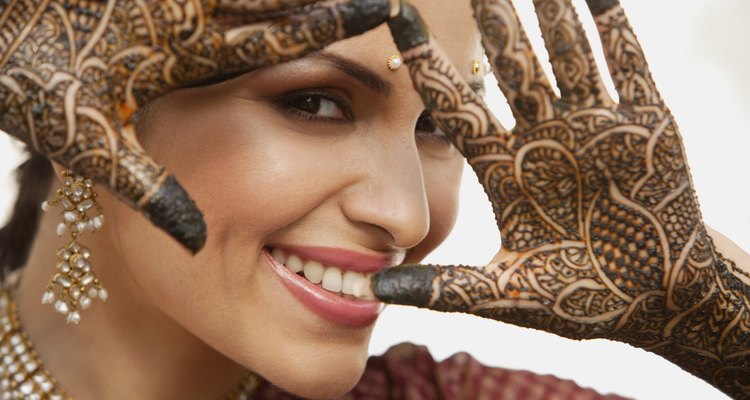
Jupiterimages/Goodshoot/Getty Images
Maintaining a happy marriage has more to do with hard work than good fortune, but a little bit of help from Lady Luck never hurts. The details of a wedding ceremony are often steeped in tradition, and those traditions can vary depending on a family's history, religion or even the bride or groom's home country. Many of them have to do with bringing good luck to the couple.
Things to Wear
Western brides know the rhyme that outlines what they are supposed to wear to ensure a happy marriage: "Something old, something new, something borrowed, something blue." The rhyme, which became popular during Victorian times, originally included "and a silver sixpence in her shoe," but today that part is usually left out. Wearing something new is said to ensure good luck and happiness for the future The borrowed object should be from a friend who has a happy marriage so the friend's happiness will rub off on the bride, but must be returned if the good luck is to last. In Greece, the bride tucks a sugar cube into her dress or gloves to ensure that life with her husband will be sweet.
Things to Do
According to a Bulgarian tradition, when you step into the church, be sure to lead with your right foot -- this means your wedding will be blessed. In some countries, the bride avoids the sight of the groom, because it is considered bad luck if her groom sees her before the ceremony. In China, the bridal party lights fireworks after the ceremony -- this chases off evil spirits. In Thailand, guests tie white strings around the bride's and groom's wrists to ensure their good luck. And in Poland, it's not only OK to cry during the wedding, it's considered lucky because it means there will be no more tears to come.
How to Decorate
In Korea, no wedding is complete without a pair of wooden ducks. These colorfully decorated creatures have a prominent place during the vow-taking, as they ensure that the bride and groom will always be close. Flowers, of course, are an important part of most wedding ceremonies. In Ireland, it's traditional to add lavender to the wedding bouquet to bring good luck and happiness. And of course, the wedding cake is a central part of any wedding. The tradition of a wedding cake originated in ancient Rome, according to the Huffington Post. Roman wedding guests would lift a loaf of bread over the bride's head and break it to ensure that she would be fertile. Today, not all brides necessarily want to be fertile, but most do want a cake.
Other Traditions
Some traditions don't sound all that pleasant, but what's a little discomfort in the name of marital bliss? In Egypt, bridesmaids give the bride a little pinch to bring her good luck. And if you find a spider in your wedding dress before you put it on, don't scream -- English tradition holds that the spider is a good omen. And although it's now the most popular day for a wedding, English folklore warns against getting married on a Saturday: According to an old rhyme, getting married on a Saturday will bring you bad luck. The same rhyme states that Wednesday is the best day to marry, and the best time of year to marry is winter.
Related Articles

Why Do Flower Girls Drop Petals?

What Color Does the Bride Wear for 3rd ...

Ideas for Brothers to Give Sisters on ...

What Happens If You Catch the Bridal ...

Wedding Dress Superstitions

The Customs of Traditional Spanish ...

Traditional Korean Wedding Gifts

How to Give the Groom His Wedding Band

Difference Between a Bridal Chorus and ...

The Meaning of Traditional Wedding Cakes

Wedding Etiquette for Couples Over 50

Do the Groom's Parents or Bride's ...

How to Blend American & Nigerian ...

Bridal Traditions: A Penny in Her Shoe

What a Minister Says at a Wedding

What Are the Family Ties for the Greek ...

How Do I Get Married at the Justice of ...

How to Give Permission to a Young Man ...

What is a Proper Gift for Italian ...

What Type of Bouquet Is Appropriate for ...
References
Photo Credits
Jupiterimages/Goodshoot/Getty Images